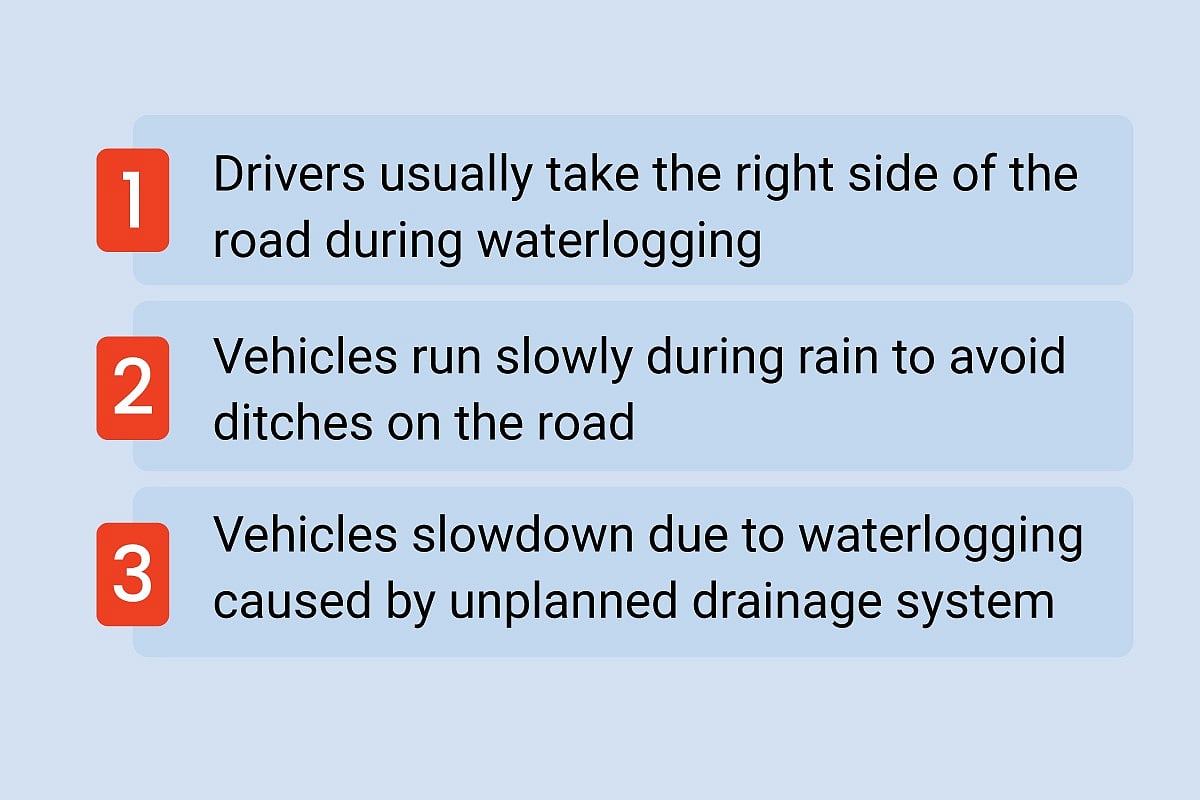3 reasons behind insufferable traffic jam in Dhaka during rain

Traffic congestion in capital Dhaka often becomes unbearable except on government holidays. And when it rains, the entire traffic system seems to fall apart.
Public transport drivers cite two specific reasons as to why the situation goes beyond during rains. First, vehicles take the right side of the road instead of left during waterlogging. Second, vehicles slow down to avoid the ditches on the road, which are very dangerous during rain.
Transport experts say waterlogging slows down the vehicles. And the unplanned and vulnerable drainage system of the city is responsible for waterlogging.
The traffic police officials didn’t deny these three observations of public transport drivers and experts either. However, they added some other factors.
Driving on the right during rain
According to the public transport drivers, they try to avoid the left side of the road as much as possible. Usually the sewers fall along the left side of the road. As a result, whenever it rains, the left side of the road goes under the water first. So, the drivers try to take the right side of the road to save the engines from water. Besides, the ditches on the roads are mostly on the left side.
Four drivers, who drive buses in the city every day, made these observations. One of then, Suman Mallik, drives on the route from Gabtoli to Demra through Mirpur, Kuril Bishwa Road and Rampura Bridge. This correspondent spoke to Suman when he was waiting for passengers in the capital’s Banashree area at around 10:00 am Friday.
He said the left of the road gets submerged when it rains. As a result, all vehicles move along the right side. Even the CNGs and motorcycles take the right side of the road. All sorts of vehicles moving through the right side, leaving the left side empty, causes severe traffic congestion and slows down the traffic speed.
However, there are some technical factors as well, according to the traffic officials. It’s not possible to figure out a sustainable solution to this without introducing an automated traffic system and finding a solution to the problems that the drivers and experts have pointed out.
Speaking to Prothom Alo, Dhaka Metropolitan Police deputy commissioner (DC) of the Tejgaon Traffic Division Mostak Ahmed said, “The motorcycle riders and their pillions take shelter at some places nearby leaving the motorcycles on the road when it starts to rain. It hampers the normal traffic movement. Besides, the vehicles cannot maintain the normal speed during the rain due to the ditches on the submerged road.”
“In addition to that, many of the vehicles take narrow lanes to reach destinations faster during rains. It creates intense traffic congestion in those streets, which eventually make the traffic situation on the main roads even worse,” he added.
According to DC Mostak Ahmed’s observation, small vehicles like the CNG-run auto-rickshaws go out of order as water enters the engine slowing down the traffic speed. Slow traffic speed in one area affects the traffic situation on the roads in other areas.
The residents of the capital have been going through immense sufferings, especially in the evening due to the heavy rains for the past few weeks. On 21 September, thousands of people were stuck on the roads for hours due to waterlogging and severe traffic congestion. They were trapped in public and personal vehicles for four to five hours. The same scenario reappeared for a few hours on 5 October.
Unplanned drainage system
The experts have blamed the weak drainage system of the city for the waterlogging. Speaking to Prothom Alo, Md Hadiuzzaman, former director of the Accident Research Institute (ARI) of the Bangladesh University of Engineering and Technology said, “The drainage system of Dhaka is not planned at all. The rain water is supposed to be cleared through the drains on both sides of the road. The middle of the roads is usually higher than wither side for easy drainage. This higher portion of the road is called ‘camber’.”
“As our drainage system is weak, water starts accumulating on both sides of the road whenever it rains. At this time, the vehicles move along the middle of the roads reducing the vehicle movement capacity of the roads to half. It is one of the main reasons behind the insane traffic congestion in the city during rain,” he said.
*This report appeared on the print and online versions of Prothom Alo and has been rewritten in English by Ashish Basu